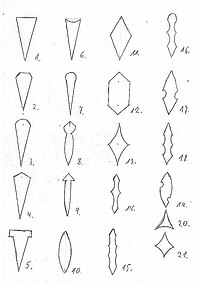Blade shape
The blade shape or blade geometry describes the profile and cross-section of the blade of a cutting tool or a bladed weapon . The intended use largely determines the shape. Sometimes the manufacturing process, wear and tear and decorations also influence the choice of shape. For stone blades z. B. The source material and coincidences play a role in the processing.
Blade shapes of knives
Knives have different blade shapes that are tailored to the respective application focus as well as material and cut .
profile
The most common profiles are:
- Normal blade
- Trailing point blade
- Clip-point blade
- Drop point blade
- Spear point blade
- Needlepoint blade
- Spay point blade
- Tanto blade
- Sheepfoot (sheep's foot) blade
- Wharncliffe Blade
- Ulu , blade of the Eskimos
- Ulu
cross-section
The blade cross-section has a great influence on the cutting properties of a knife. Many knives are now delivered with a two-bevel edge. The blade is divided into mirror, bevel and bevel from the back of the blade to the cutting edge.
The mirror makes up most of the blade. In the case of artistic knives, it is polished or decorated by etching or engraving. Functional modifications are also made here to some kitchen knives, e.g. B. so that the clippings are more easily detached from the blade, there are small dents or even large recesses (see cheese knife ).
The first bevel behind the mirror is the bevel, also called the primary bevel. The bevel serves to reduce the work involved in creating and later re-sharpening the cutting bevel. The choice of the bevel depends on the purpose of the knife, because it is decisive for its cutting ability and edge retention . Typical grind types are flat, hollow and ball grind .
The cutting bevel or secondary bevel is the final grind that gives the blade its sharp edge. Usually only this bevel is sharpened when the blade becomes blunt. Occasionally forms on the cutting a microbevel (in particular also Wate called). This happens when the blade is leathered on a paste belt to reduce the burr.
Cross sections of blades
Different blade cross-sections can be observed on sword , epee , saber , dagger or knife . The cross-sectional shapes are described according to generally known objects and figures. They are named like this:
- Full blade with a flat back
- Full blade with half back
- Full blade with a round back
- Full blade with a pointed back
- Full double-backed blade
- Full hollow back blade
- Plug-back blade
- Blade with a pointed back
- Triangular plug-in back blade
- Full double-edged blade
- Ridge blade (blade with a diamond-shaped cross-section)
- Hexagonal blade
- Central rib blade (or hollow ground ridge blade)
- Two-lane mid-rib blade
- Double ribbed blade
- Two-way blade (double hollow)
- Blade with single fullers on both sides
- Blade with double fullers on both sides
- Lesghian blade
- Triangular hollow blade
- Square hollow ground blade
- Blade of cruciform cross-section
- A maple blade, also known as a triangular hollow blade, is forged with three edges and is hollow-ground on all three sides of the blade. These blades are used on bayonets, armor piercers, daggers and rapiers. In cross-section, these blades correspond to an isosceles triangle with concave sides.
- Blade with one-sided hollow path
- Blade with double-sided hollow path
See also
literature
- Ruth Maria Hirschberg Knife Forms in the High Middle Ages with special consideration of the Mark Brandenburg , Berlin, 2005 Online PDF file
- Gerhard Folke Wulf Holtmann, Investigation of Medieval and Early Modern Knives , Göttingen, 1993 online PDF file
Web links
- List of all common blade shapes
- A film about the blade and its shapes , explains the parts of the blade, common blade shapes, types of bevel as well as recurve and serrated edges
Individual evidence
- ^ A b Leonhard Ullrich: Small knife science. Retrieved January 28, 2015 .
- ↑ Gerhard Seifert: Technical terms of the edged weapons knowledge. German ABC of the European naked defensive weapons. (Cut, thrust, hit and hand thrown weapons). Verlag Seifert, Haig 1981.


